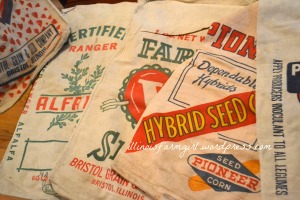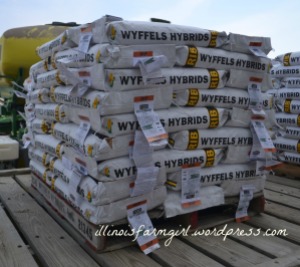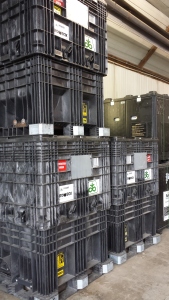As with so many other aspects of farming, farmers have a choice when it comes to how their seed is packaged. Just like the grocer used to ask, “Paper or plastic”, these days a seed sale representative will ask, “Bag or box?”
 Seeds have arrived to the farmer in bags for decades. When we were cleaning out my grandparents’ home last spring, we found rolls of burlap sacks in which Grandpa would receive and or store seed for corn, wheat, alfalfa, oats, etc.
Seeds have arrived to the farmer in bags for decades. When we were cleaning out my grandparents’ home last spring, we found rolls of burlap sacks in which Grandpa would receive and or store seed for corn, wheat, alfalfa, oats, etc.
 Eventually, seed started to arrive in paper bags, stacked on pallets, shrink wrapped and delivered to the farm. Pallets were set on hayracks (pictured) or single bags in truck beds and hauled to the fields to load planters. Depending how many acres the farmer was planting and which hybrid was going where determined how many bags of seed were ordered.
Eventually, seed started to arrive in paper bags, stacked on pallets, shrink wrapped and delivered to the farm. Pallets were set on hayracks (pictured) or single bags in truck beds and hauled to the fields to load planters. Depending how many acres the farmer was planting and which hybrid was going where determined how many bags of seed were ordered.
When bulk fill planters entered the marketplace, farmers found they could cover more acres before needing to refill the planter. We run a bulk fill planter as described in The Anatomy of a Planter.
 With the advent of bulk fill planters came Pro Boxes. This article from 2011 published in Farm Industry News also talks about bags vs. boxes. Pro Boxes are large black plastic boxes that hold 50 bushels of seed. One pro-box can fill one bulk tank on the planter. The boxes are water tight, rodent proof, and won’t break when hit with the forks of a forklift. (We’ve had personal experience with that.)
With the advent of bulk fill planters came Pro Boxes. This article from 2011 published in Farm Industry News also talks about bags vs. boxes. Pro Boxes are large black plastic boxes that hold 50 bushels of seed. One pro-box can fill one bulk tank on the planter. The boxes are water tight, rodent proof, and won’t break when hit with the forks of a forklift. (We’ve had personal experience with that.)
After planting, Pro Boxes are returned to the seed sales rep for use next year. Bags are usually burned field side to keep them from taking flight on a windy day.
Are Pro Boxes the future of seed packaging? Maybe. Maybe not. Dumping bags of seed is actually significantly less complex and less expensive than dumping a Pro Box. There are a variety of ways to dump a pro-box. A $10,000 seed tender can be used. A seed tender can be a trailer on which the Pro Boxes are set (two or four of them). An auger runs the length of the trailer moving seed from the boxes to the planter. It can also be a wagon in which the seed is dumped and then augured to the planter. We use a poly funnel and a forklift to lift the boxes and funnel the seed into the tanks. The downside is we can’t fill the planter in the field (no forklifts in the fields), so will return home once maybe twice a day to refill the planter.
BONUS: Call the kids, break out the pencils and paper and prepare to think. Seed bags and boxes have a lot to do with math.
On our farm we plant multiple hybrids of corn and varieties of soybeans. Some of our fields are large (360 acres) and some are small (20 acres). When we order seed, we have to first determine which hybrid will be planted in which field, how much seed we will plant per acre (i.e. plant population) and then figure out how much of that seed we need.
One bag of corn seed contains 80,000 kernels and will plant a little more than two acres (or football fields). One pro-box equals 50 bags of seed and will plant a little more than 100 acres. Although plant population varies from field to field, we average 35,000 seeds/kernels per acre.
Here’s the questions:
- If we were to plant our smallest field (20 acres) with a ‘box’ of seed, how much of that box would we use? Would it be better to use bags or boxes for this small field?
- If we decided to plant our largest field with one hybrid, how many boxes and or bags would we need to order to cover the field?
Leave your answer in the comments section and I’ll post the answers to the blog’s facebook page and in the comments section of this post on Friday.




Leave a Reply